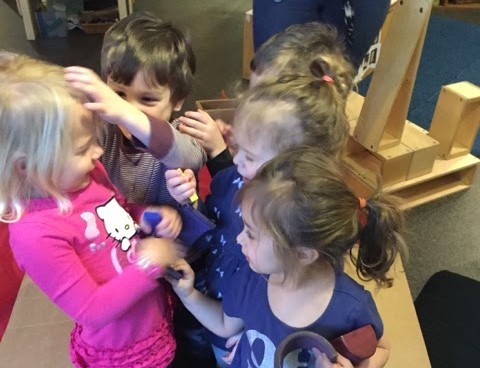
Supporting Children in Conflict
by Cassie Tondreau, Educator, Hilltop Children’s Center
Does this sound familiar?
“No, I was here first!”
“It’s mine! Don’t take it!”
“She’s not listening!”
We’ve all heard the familiar refrain of children fighting, squabbling, arguing, or disagreeing. Conflict between children has many different names and just as many levels of intensity. Hearing this type of conflict between children can cause a major reaction in us, for better or for worse. At times our instinct is to extinguish the conflict as quickly as possible, even if it makes us feel that justice hasn’t been served for either party.
As I’ve reflected on my practice as an educator, one of the skills I’ve hoped to help develop in my students is conflict resolution. It’s a disposition that can pertain to any part of their day, and almost every type of play they encounter. Guiding children through conflict helps them cultivate ideas about fairness and equity, and deepens their feelings around identity, empathy, and emotional intelligence. We can all agree that there is huge value in this endeavor for children and adults alike. The big question that comes up is how and when to step in to help solve a conflict. Do we want to outline a prescribed procedure for the child to adhere to in their solutions with their peers, or do we want to allow them space to experience the conflict and arrive at a resolution on their own?
As educators and parents, we have several tools in our arsenal to help children generate their own solutions. A great first step is to call out what you see, or narrate the experience of the children as it happens.
“Ian, you have the ball. Joey, you want the ball, and you’ve told Ian twice that you want it. What should you try next, Joey? Ian, I wonder how Joey is feeling.”
This strategy can help children to see the situation from outside themselves, and could help them identify with the other person.
We also strive to patiently watch the conflict play out, allowing the children to solve the issue in their own time. As adults we have years of experience handling and resolving conflict, but a child does not. Each situation can feel singular in its intensity and emergency, and giving them the time to work through the ensuing emotions is very helpful for their confidence as a problem-solver.
Why do we have the instinct to stop conflict quickly? Obvious answers such as fear for the child’s safety come to mind, a very valid and important thing to be mindful of as we help children traverse this challenging territory. Do we stop conflict such as shouting, two children having a vocal disagreement over space, tools, friends, or any number of possibilities because we fear for the chance that they might get hurt? Do we feel that we have the right answer to the particular conflict going on between the children and therefore need to step in? Do we worry as we recall our own experience of conflict as a child, and stop it due to its triggering effect on us? Can we picture ourselves in the child’s shoes, imagining the work they’ve done, what they need, and their history with the other child? If we did, would we make the same suggestions to resolve the conflict?
Here are some questions to consider, in reflecting on your own values around conflict resolution among children:
- How was conflict handled in your childhood: lots of adult intervention, no adult intervention, or somewhere in between?
- What makes you step in to a conflict between children?
- What types of scenarios trigger a big response from you?
- How does the philosophy of conflict resolution change between an adult caretaker and a child as opposed to between two children?
[author] [author_image timthumb=’on’]https://hilltopcc.com/wp-content/uploads/2014/12/Cassie.jpg[/author_image] [author_info]Cassie Tondreau is an Educator with two- and three-year-olds at Hilltop Children’s Center, where she has worked since 2011.[/author_info] [/author]
2 thoughts on “Supporting Children in Conflict”
Comments are closed.
Oh-so-relevant. Always! In fact, I just walked out of our classroom after working with two people trying to decide whose turn it would be to read to the “Where’s Waldo?” book on their mat during Rest Time. Pulling and tugging and yelling and pushing. As you said, the intensity and the urgency is palpable.
To answer some of your reflection questions, I am quite sure that I had a childhood filled with kids moving through their own open-ended conflict resolution strategies, and yet I still have an innate impulse to want to step in to “help” quite a lot. I think it takes time to even realize that you may be prematurely jumping in, and it takes even more time to redirect that behavior into more of a facilitator-like role. The practice of narrating has saved me (from myself) many times because it forces me to slow down and be present with the children who are in conflict. When I realize my place of authority, I can choose how and when to enact it. Thank you for articulating this complex, crucial aspect of daily preschool life.
Such a great piece, Cassie. I especially appreciated your reflective questions at the end. I am thinking the most about this question you posed: “Can we picture ourselves in the child’s shoes, imagining the work they’ve done, what they need, and their history with the other child? If we did, would we make the same suggestions to resolve the conflict?” Great guidance for me as an educator…thank you!